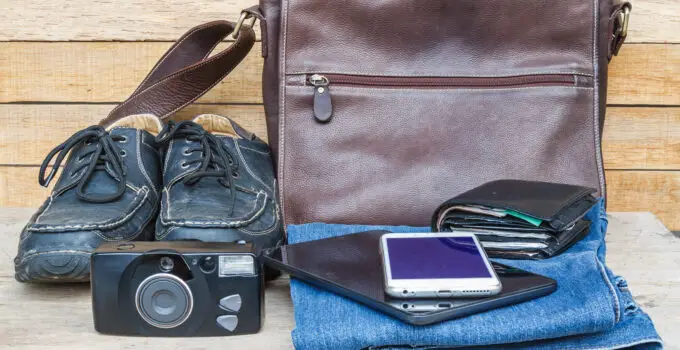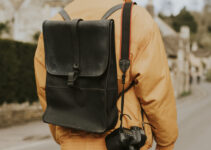Ever wondered how to make a Domke camera bag?
Crafting your own customized camera bag can be both rewarding and practical, providing protection for your gear while reflecting your personal style.
To make a Domke camera bag, you need durable fabric, padding, sturdy zippers, and a bit of sewing know-how.
In this guide, we will walk you through the step-by-step process of creating your own bespoke camera bag, ensuring it meets all your needs.
Ready to dive into the world of DIY camera gear?
Let’s explore the detailed instructions and expert tips from seasoned photographers and bag designers to help you create a functional and stylish Domke camera bag.
Here how to make a camera tripod bag?
What is Domke camera bag?
Domke camera bags are high-quality, durable bags designed specifically for photographers.
They are renowned for their practical, user-friendly design, which prioritizes ease of access, comfort, and protection for photography gear.

Created by Jim Domke in 1976, these bags quickly became a favorite among professional photographers due to their functional design and robust construction.
Domke bags typically feature a rugged, canvas material that is water-resistant and built to withstand heavy use.
The interiors are customizable with padded dividers, allowing photographers to organize their equipment efficiently.
These bags also come with numerous pockets and compartments, providing ample storage for cameras, lenses, accessories, and personal items.
Their signature gripper strap ensures the bag stays securely on the shoulder, while the ergonomic design distributes weight evenly, making them comfortable for long-term use.
Domke camera bags are celebrated for blending durability with practicality, catering to the needs of both amateur and professional photographers.
Where are Domke bags made?
Domke bags are made in the United States.
Here, how to make a camera lens bag?
Since their inception in 1976, Domke bags have been manufactured with a commitment to quality and craftsmanship, reflecting the needs of professional photographers.
The bags are produced using durable materials such as rugged canvas and ballistic nylon, which are chosen for their resilience and ability to protect valuable camera equipment.
The production process in the U.S. ensures meticulous attention to detail and adherence to high standards of construction.
This domestic manufacturing also allows Domke to maintain strict quality control, ensuring that each bag meets the expectations of durability and functionality that photographers rely on.
Domke’s commitment to local manufacturing underscores their dedication to producing reliable and long-lasting camera bags that serve the practical needs of photographers worldwide.
Do you really need a domke camera bag?
Whether you need a Domke camera bag depends on your specific requirements as a photographer.
Domke bags are renowned for their durability, functionality, and user-friendly design, making them a valuable investment for many photographers.
If you frequently shoot in demanding environments, need quick access to your gear, or prioritize a rugged and comfortable bag, a Domke camera bag could be an excellent choice.
For professional photographers or serious hobbyists who carry multiple cameras, lenses, and accessories, the customizable interiors and numerous compartments of Domke bags offer significant benefits.
However, if you are a casual photographer with minimal gear or prefer a more stylish or compact bag, other options might better suit your needs.
Here, how to make a camera bag waterproof.
Ultimately, the decision should be based on how well a Domke bag aligns with your photography style, the level of protection and organization you require, and your personal preferences in terms of design and comfort.
Why you need a domke camera bag?
You might need a Domke camera bag if you require a durable, practical, and reliable solution for transporting your photography equipment.
Domke bags are designed with photographers in mind, offering several key benefits:
- Durability: Made from rugged materials like canvas and ballistic nylon, Domke bags are built to withstand tough conditions, ensuring long-term protection for your gear.
- Accessibility: The design allows for quick and easy access to your equipment, which is crucial for capturing spontaneous moments.
- Customization: The interior compartments are customizable with padded dividers, enabling you to organize your cameras, lenses, and accessories efficiently.
- Comfort: The ergonomic design and gripper strap provide comfort during long shoots, distributing weight evenly and preventing the bag from slipping.
- Professional Use: Trusted by professional photographers, Domke bags offer a blend of functionality and style, meeting the high demands of daily use in various environments.
If these factors align with your photography needs, a Domke camera bag could be an ideal choice.
Here, how to make a camera bag at home.
Are Domke camera bag worth it?
Things to know before making a domke camera bag
Before making a Domke camera bag, consider the following key factors:
- Material Selection: Choose durable materials like rugged canvas or ballistic nylon to ensure the bag can withstand harsh conditions and provide long-term protection for camera gear.
- Design and Functionality: Focus on creating a practical, user-friendly design with easy access to equipment. Incorporate customizable padded dividers to help photographers organize their gear efficiently.
- Comfort and Ergonomics: Design the bag with a non-slip gripper strap and ergonomic features to distribute weight evenly, providing comfort during long shoots.
- Quality and Craftsmanship: Ensure high-quality construction with meticulous attention to detail to meet the expectations of professional photographers.
- Market Research: Understand the needs and preferences of your target audience. This includes considering various sizes and styles to cater to different types of photographers and their equipment.
- Brand Reputation: Build a reputation for reliability and practicality, as Domke has done, to attract a loyal customer base.
How to make a domke camera bag?
To make a Domke-style camera bag, follow these steps:
- Design Planning: Sketch a practical design focusing on accessibility and organization. Include compartments, pockets, and customizable padded dividers.
- Material Selection: Choose durable, weather-resistant materials like rugged canvas or ballistic nylon for the exterior, and soft, padded fabric for the interior to protect equipment.
- Cutting and Sewing: Cut the fabric according to your design patterns. Sew the pieces together, ensuring strong, reinforced seams to handle heavy gear.
- Adding Compartments: Incorporate multiple pockets and adjustable dividers using Velcro to allow for flexible storage and organization.
- Straps and Handles: Attach a non-slip gripper strap and ergonomic handles for comfortable carrying. Reinforce attachment points to ensure durability.
- Quality Check: Inspect the bag thoroughly for any defects or weak points. Ensure zippers, seams, and straps are robust and function smoothly.
- Field Testing: Test the bag with actual camera gear to ensure it meets the practical needs of photographers, making adjustments as necessary.
Here, how to make a insulated camera bag?
9 steps to make a domke camera bag
1. Design Planning
Begin by conceptualizing the design of your Domke-style camera bag. Consider the needs of photographers: easy access to gear, sufficient storage, and durability.
Sketch the layout, detailing the size and placement of compartments, pockets, and dividers.
Decide on the overall dimensions to accommodate various types of camera equipment. Include features like quick-access pockets and customizable interior spaces to enhance functionality.
2. Material Selection
Select high-quality, durable materials. Domke bags are known for their rugged canvas or ballistic nylon exteriors, which provide excellent protection against the elements.
Choose a soft, padded fabric for the interior to cushion the camera and lenses. Opt for water-resistant materials to protect the gear in adverse weather conditions.
Ensure all materials are sturdy enough to withstand frequent use and heavy loads.
3. Pattern Making
Create detailed patterns for each part of the bag. This includes the main body, pockets, dividers, and straps.
Use your design sketches to develop precise templates. Accurate patterns are crucial for ensuring that all pieces fit together correctly.
Consider making a prototype from cheaper material to refine the patterns before cutting the final fabric.
4. Cutting Fabric
Using the patterns, cut the fabric carefully. Precision is key to avoid wastage and ensure all parts fit together seamlessly.
Double-check measurements before cutting to avoid errors. Lay out all the pieces to ensure nothing is missing and that everything aligns with your design plan.
Here, how to make a camera bag for DSLR.
5. Sewing and Assembly
Start by sewing smaller components like pockets and dividers.
Gradually assemble these into the larger sections of the bag. Use strong, reinforced stitching to enhance durability, especially at stress points.
Consider using a heavy-duty sewing machine capable of handling thick fabrics. Pay attention to seam allowances and ensure all edges are neatly finished.
6. Adding Compartments
Incorporate the compartments and pockets as per your design. Use Velcro for adjustable dividers to allow photographers to customize the interior layout.
Ensure pockets are securely attached and provide adequate storage for smaller items like memory cards, batteries, and filters. Test each compartment to ensure it functions as intended.
7. Straps and Handles
Attach the shoulder strap and handles.
Use a non-slip gripper strap for the shoulder to prevent slipping. Reinforce attachment points to withstand the weight of the equipment.
Ensure the straps are adjustable for comfort. Test the handles for strength and ease of carrying, and make any necessary adjustments for ergonomic comfort.
8. Quality Check
Conduct a thorough quality inspection. Check all seams, zippers, and attachments for robustness.
Ensure the zippers move smoothly and do not snag. Examine the bag for any weak points or loose threads.
Test the bag with weights similar to camera gear to ensure it can handle the load without strain.
9. Field Testing
Finally, test the bag in real-world conditions. Load it with camera equipment and use it as a photographer would.
Assess the ease of access, comfort during use, and the functionality of all compartments.
Get feedback from actual users if possible and make necessary adjustments based on their input.
This step is crucial to ensure the bag meets the practical needs of photographers and performs well under various conditions.
Here, does ospery make a camera bag.
How to wax a domke bag?
To wax a Domke bag, follow these steps for optimal protection and longevity:
- Clean the Bag: Ensure the bag is clean and dry. Use a brush to remove dirt and dust, and wipe it down with a damp cloth if necessary. Let it dry completely.
- Choose Wax: Select a suitable wax, such as a fabric wax or beeswax, specifically designed for canvas materials.
- Apply Wax: Rub the wax bar directly onto the fabric in small sections. Apply evenly, covering all areas, including seams and edges.
- Heat the Wax: Use a hairdryer or heat gun to melt the wax into the fabric. Hold the dryer a few inches away and move it around to ensure even absorption. The fabric will darken slightly as the wax melts in.
- Let it Set: Allow the bag to cool and the wax to harden. This process helps create a water-resistant barrier.
Repeat as needed for additional protection.
Conclusion:
In conclusion, crafting a Domke camera bag requires attention to detail, quality materials like canvas or leather, and a thorough understanding of sewing techniques.
The result is a durable, functional, and stylish bag that photographers trust to protect their gear while on the move.








